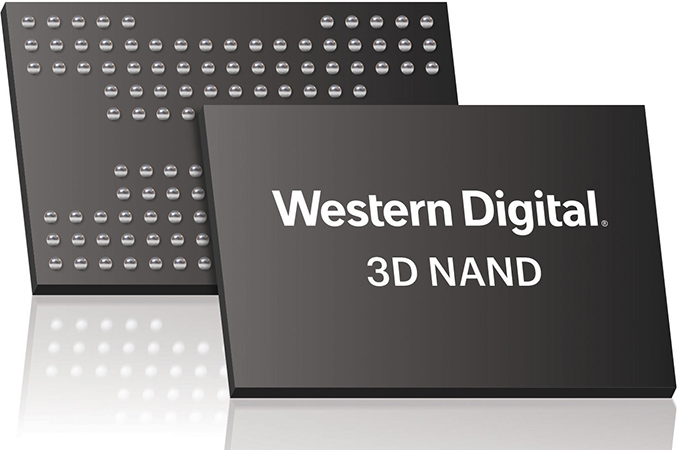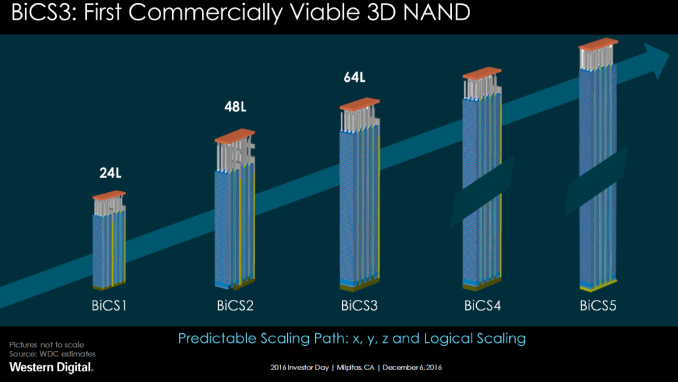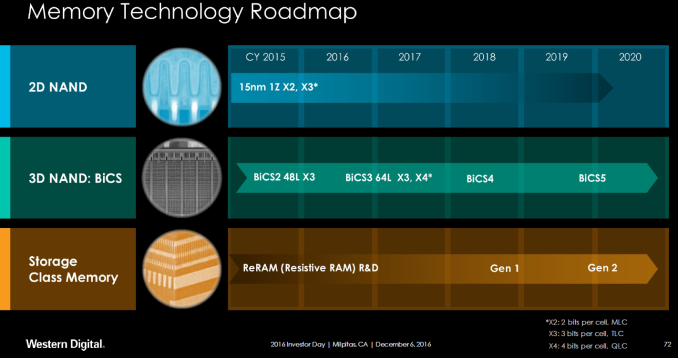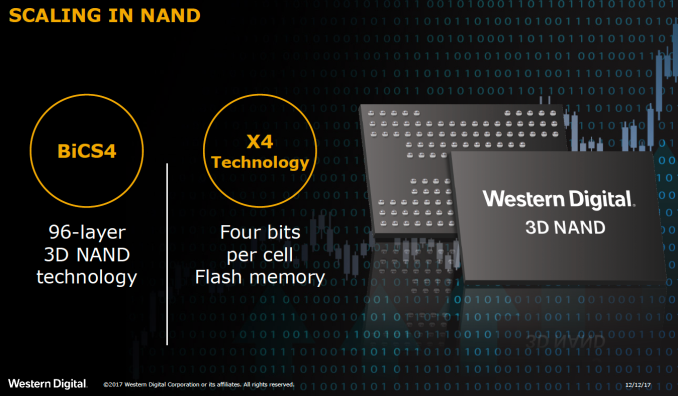Western Digital: 96-Layer 3D NAND Progressing Well, Shipping to Retail Customers
by Anton Shilov on May 29, 2018 8:00 AM EST
Western Digital this month said that it had started shipments of its fourth-generation BiCS 3D NAND memory to some of its customers. The company did not disclose details, but only said that the 96-layer 3D NAND memory is used for storage devices sold in retail, which usually means that it is used for inexpensive flash drives and/or memory cards. One of the important things about Western Digital’s BiCS4 memory is the manufacturer’s plan to build both TLC and QLC NAND using the technology.
Western Digital started production of its 96-layer BiCS4 NAND memory earlier this year and confirmed the beginning of the ramp up in late April during a conference call. At the J.P. Morgan Global Technology, Media and Communications conference in mid-May the company said that it had started to ship the said chips for revenue to its retail customers. Western Digital does not give any guidelines regarding the pace of the ramp up and the time when shipments of BICS4 exceed shipments of BICS3, but the fact that the ICs are used commercially is important.
“BiCS4, which is 96 layers, we have introduced that technology and we are shipping it primarily to our retail customers,” said Steve Milligan, CEO of Western Digital. “If you look to where we at from a yield curve perspective, because [BICS4] is not too mature, we are very pleased with where we are. Because once you get to a certain point, you can project where you are going to end at (based on cycles of learning, etc). So, the 96-layer technology is progressing quite well, we continue to increase output of that as we move to the rest of 2018, I am very thrilled and grateful for our strong 3D NAND execution.”
Western Digital’s (and Toshiba’s) BICS4 is a name for a family of 3D NAND flash devices featuring 96 active word lines (or layers). The lineup will include both TLC and QLC chips with capacities ranging from 256 Gb to 1 Tb. Based on Western Digital’s announcement from 2017, its first chips to use 96 word layers are 256 Gb 3D TLC NAND devices. After the manufacturer figures out how to produce 96-layer 3D NAND with sufficient yields, it will move on to higher-capacity 3D TLC and eventually 3D QLC chips with up to 1 Tb (128 GB) capacity.
Speaking of QLC, it is necessary to point out that last year Western Digital and Toshiba also announced 768 Gb BICS3 64-layer 3D QLC NAND memory and it is highly likely that such ICs will hit the market earlier than 96-layer QLC NAND. Nonetheless, QLC is a crucial part of Western Digital’s future plans.
Related Reading:
- Western Digital Announce BiCS4 3D NAND: 96 Layers, TLC & QLC, Up to 1 Tb per Chip
- Western Digital Announces Four Bit Per Cell 64-Layer 3D NAND Flash
- Toshiba's 768Gb 3D QLC NAND Flash Memory: Matching TLC at 1000 P/E Cycles?
- Intel And Micron Launch First QLC NAND: Micron 5210 ION Enterprise SATA SSD
Source: Western Digital













29 Comments
View All Comments
R0H1T - Tuesday, May 29, 2018 - link
I'm guessing no one asked them about the vaporware *ReRAM?*in development since temps immémorial.
MajGenRelativity - Tuesday, May 29, 2018 - link
It's not supposed to land until the end of the year according to that chartR0H1T - Tuesday, May 29, 2018 - link
Yes but one would hope that if there are working prototypes, then by now we'd see them somewhere? That doesn't seem to be the case, not even rumors IIRC.MajGenRelativity - Tuesday, May 29, 2018 - link
Fair enough. I'm not sure what is going on. Maybe they're trying to play things differently from Samsung and are going to hide their Optane competitor until it is ready to go?CaedenV - Tuesday, May 29, 2018 - link
More likely than not they are looking at how much of a loosing proposition that ReRam, XPointe, and other such 'between RAM and storage' solutions are, and are just sitting on it. Keep it on the calendar to make them look competitive with Intel to shareholders, but never make a move to prevent them from loosing money on a niche technology that very few people are actually asking for.MajGenRelativity - Tuesday, May 29, 2018 - link
3DXpoint is actually a very valuable technology. If Intel can lower the cost for the second generation, it would become far less of a niche product, and it already has a fairly sizable market right now.ZeDestructor - Tuesday, May 29, 2018 - link
The other part of that is that we're still waiting on Intel/Micron to ship Optane-based NVDIMMswanderer66 - Wednesday, May 30, 2018 - link
Almost certain that's a power-draw issue at this point.DanNeely - Tuesday, May 29, 2018 - link
Halving the price would begin to let it cut into the SSD market directly; especially if they can get the power low enough to make it a reasonable option for laptops. A $110 for 120GB 3x point module would be big enough to serve as the only drive on a lot of mainstream systems; and is affordable enough to make dual partition enthusiast setups viable; similar to how many of us had a 120/240GB SSD and an HDD a few years back when 512GB of flash was prohibitively expensive.A second halving of price would put it at the same ~1TB for $500 price range when I went pure SSD for my main system, and would be borderline viable for my switching over it when I build a new system in a few years. (Depends on if software bloat has me thinking I'd need 2TB to be safe or not.)
MajGenRelativity - Tuesday, May 29, 2018 - link
Halving the price would definitely be a big step, especially with a power consumption decrease. Hopefully Intel can make some steps in that direction.